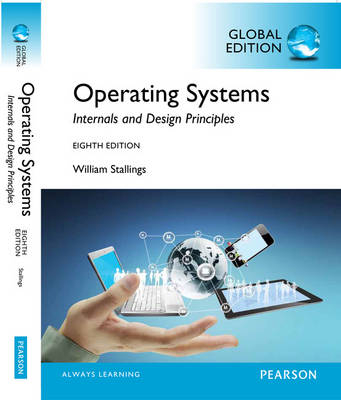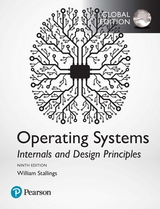
Operating Systems: Internals and Design Principles, Global Edition
Pearson Education Limited
978-1-292-06135-1 (ISBN)
- Titel erscheint in neuer Auflage
- Artikel merken
Operating Systems: Internals and Design Principles provides a comprehensive and unified introduction to operating systems topics. Stallings emphasizes both design issues and fundamental principles in contemporary systems and gives readers a solid understanding of the key structures and mechanisms of operating systems. He discusses design trade-offs and the practical decisions affecting design, performance and security. The book illustrates and reinforces design concepts and ties them to real-world design choices through the use of case studies in Linux, UNIX, Android, and Windows 8.
Teaching and Learning Experience
This program presents a better teaching and learning experience-for you and your students. It will help:
Illustrate Concepts with Running Case Studies: To illustrate the concepts and to tie them to real-world design choices that must be made, four operating systems serve as running examples.
Easily Integrate Projects in your Course: This book provides an unparalleled degree of support for including a projects component in the course.
Keep Your Course Current with Updated Technical Content: This edition covers the latest trends and developments in operating systems.
Provide Extensive Support Material to Instructors and Students: Student and instructor resources are available to expand on the topics presented in the text.
Chapter 0 Guide for Readers and Instructors 0.1 Outline of the Book
0.2 A Roadmap for Readers and Instructors
0.3 Internet and Web Resources
PART ONE BACKGROUND
Chapter 1 Computer System Overview1.1 Basic Elements
1.2 Evolution of the Microprocessor
1.3 Instruction Execution
1.4 Interrupts
1.5 The Memory Hierarchy
1.6 Cache Memory
1.7 Direct Memory Access
1.8 Multiprocessor and Multicore Organization
1.9 Recommended Reading and Web Sites
1.10 Key Terms, Review Questions, and Problems
Appendix 1A Performance Characteristics of Two-Level Memory
Chapter 2 Operating System Overview2.1 Operating System Objectives and Functions
2.2 The Evolution of Operating Systems
2.3 Major Achievements
2.4 Developments Leading to Modern Operating Systems
2.5 Virtual Machines
2.6 OS Design Considerations for Multiprocessor and Multicore
2.7 Microsoft Windows Overview
2.8 Traditional UNIX Systems
2.9 Modern UNIX Systems
2.10 Linux
2.11 Android
2.12 Recommended Reading and Web Sites
2.13 Key Terms, Review Questions, and Problems
PART TWO PROCESSES
Chapter 3 Process Description and Control 3.1 What Is a Process?
3.2 Process States
3.3 Process Description
3.4 Process Control
3.5 Execution of the Operating System
3.6 UNIX SVR4 Process Management
3.7 Summary
3.8 Recommended Reading and Animations
3.9 Key Terms, Review Questions, and Problems
Chapter 4 Threads4.1 Processes and Threads
4.2 Types of Threads
4.3 Multicore and Multithreading
4.4 Windows 8 Process and Thread Management
4.5 Solaris Thread and SMP Management
4.6 Linux Process and Thread Management
4.7 Android Process and Thread Management
4.8 Mac OS X Grand Central Dispatch
4.9 Summary
4.10 Recommended Reading
4.11 Key Terms, Review Questions, and Problems
Chapter 5 Concurrency: Mutual Exclusion and Synchronization5.1 Principles of Concurrency
5.2 Mutual Exclusion: Hardware Support
5.3 Semaphores
5.4 Monitors
5.5 Message Passing
5.6 Readers/Writers Problem
5.7 Summary
5.8 Recommended Reading and Animations
5.9 Key Terms, Review Questions, and Problems
Chapter 6 Concurrency: Deadlock and Starvation6.1 Principles of Deadlock
6.2 Deadlock Prevention
6.3 Deadlock Avoidance
6.4 Deadlock Detection
6.5 An Integrated Deadlock Strategy
6.6 Dining Philosophers Problem
6.7 UNIX Concurrency Mechanisms
6.8 Linux Kernel Concurrency Mechanisms
6.9 Solaris Thread Synchronization Primitives
6.10 Windows Concurrency Mechanisms
6.11 Android Interprocess Communications
6.12 Summary
6.13 Recommended Reading
6.14 Key Terms, Review Questions, and Problems
PART THREE MEMORY
Chapter 7 Memory Management7.1 Memory Management Requirements
7.2 Memory Partitioning
7.3 Paging
7.4 Segmentation
7.5 Summary
7.6 Recommended Reading and Animations
7.8 Key Terms, Review Questions, and Problems
Appendix 7A Loading and Linking
Chapter 8 Virtual Memory8.1 Hardware and Control Structures
8.2 Operating System Software
8.3 UNIX and Solaris Memory Management
8.4 Linux Memory Management
8.5 Windows Memory Management
8.6 Android Memory Management
8.7 Summary
8.8 Recommended Reading and Web Sites
8.9 Key Terms, Review Questions, and Problems
PART FOUR SCHEDULING
Chapter 9 Uniprocessor Scheduling9.1 Types of Scheduling
9.2 Scheduling Algorithms
9.3 Traditional UNIX Scheduling
9.4 Summary
9.5 Recommended Reading and Animations
9.6 Key Terms, Review Questions, and Problems
Chapter 10 Multiprocessor and Real-Time Scheduling10.1 Multiprocessor and Multicore Scheduling
10.2 Real-Time Scheduling
10.3 Linux Scheduling
10.4 UNIX SVR4 Scheduling
10.5 UNIX FreeBSD Scheduling
10.6 Windows Scheduling
10.7 Summary
10.8 Recommended Reading
10.9 Key Terms, Review Questions, and Problems
PART FIVE INPUT/OUTPUT AND FILES
Chapter 11 I/O Management and Disk Scheduling11.1 I/O Devices
11.2 Organization of the I/O Function
11.3 Operating System Design Issues
11.4 I/O Buffering
11.5 Disk Scheduling
11.6 RAID
11.7 Disk Cache
11.8 UNIX I/O
11.9 Linux I/O
11.10 Windows I/O
11.11 Summary
11.12 Recommended Reading
11.13 Key Terms, Review Questions, and Problems
Chapter 12 File Management12.1 Overview
12.2 File Organization and Access
12.3 B-Trees
12.4 File Directories
12.5 File Sharing
12.6 Record Blocking
12.7 Secondary Storage Management
12.8 UNIX File Management
12.9 Linux Virtual File System
12.10 Windows File System
12.11 Android File Management
12.12 Summary
12.13 Recommended Reading
12.14 Key Terms, Review Questions, and Problems
PART SIX ADVANCED TOPICS
Chapter 13 Embedded Operating Systems13.1 Embedded Systems
13.2 Characteristics of Embedded Operating Systems
13.3 Embedded Linux
13.4 TinyOS
13.5 Embedded Linux
13.5 Recommended Reading
13.6 Key Terms, Review Questions, and Problems
Chapter 14 Virtual Machines14.1 Approaches to Virtualization
14.2 Processor Issues
14.3 Memory Management
14.4 I/O Management
14.5 VMware ESXi
14.6 Microsoft Hyper-V and Xen Variants
14.7 Java VM
14.8 Linux VServer Virtual Machine Architecture
14.9 Android Virtual Machine
14.10 Recommended Reading
14.11 Key Terms, Review Questions, and Problems
Chapter 15 Operating System Security15.1 Intruders and Malicious Software
15.2 Buffer Overflow
15.3 Access Control
15.4 UNIX Access Control
15.5 Operating Systems Hardening
15.6 Security Maintenance
15.7 Windows Security
15.8 Recommended Reading
15.9 Key Terms, Review Questions, and Problems
Chapter 16 Distributed Processing, Client/Server, and Clusters16.1 Client/Server Computing
16.2 Distributed Message Passing
16.3 Remote Procedure Calls
16.4 Clusters
16.5 Windows Cluster Server
16.6 Beowulf and Linux Clusters
16.7 Summary
16.8 Recommended Reading
16.9 Key Terms, Review Questions, and Problems
APPENDICESAppendix A Topics in Concurrency
Appendix B Programming and Operating System Projects ReferencesIndex
Acronyms
ONLINE CHAPTERS AND APPENDICES[1]
Chapter 17 Network Protocols17.1 The Need for a Protocol Architecture
17.2 The TCP/IP Protocol Architecture
17.3 Sockets
17.4 Linux Networking
17.5 Summary
17.6 Recommended Reading and Web Sites
17.7 Key Terms, Review Questions, and Problems
Appendix 17A The Trivial File Transfer Protocol
Chapter 18 Distributed Process Management 18.1 Process Migration
18.2 Distributed Global States
18.3 Distributed Mutual Exclusion
18.4 Distributed Deadlock
18.5 Summary
18.6 Recommended Reading
18.7 Key Terms, Review Questions, and Problems
Chapter 19 Overview of Probability and Stochastic Processes19.1 Probability
19.2 Random Variables
19.3 Elementary Concepts of Stochastic Processes
19.4 Recommended Reading and Web Sites
19.5 Key Terms, Review Questions, and Problems
Chapter 20 Queueing Analysis20.1 How Queues Behave-A Simple Example
20.2 Why Queuing Analysis?
20.3 Queueing Models
20.4 Single-Server Queues
20.5 Multiserver Queues
20.6 Examples
20.7 Queues with Priorities
20.8 Networks of Queues
20.9 Other Queueing Models
20.10 Estimating Model Parameters
20.11 Recommended Reading and Web Sites
20.12 Key Terms, Review Questions, and Problems
Programming Project One Developing a Shell
Programming Project Two The HOST Dispatcher Shell
Appendix C Topics in Computer Organization
Appendix D Object-Oriented Design
Appendix E Amdahl's Law
Appendix F Hash Tables
Appendix G Response Time
Appendix H Queueing System Concepts
Appendix I The Complexity of Algorithms
Appendix J Disk Storage Devices
Appendix K Cryptographic AlgorithmsAppendix L Standards Organizations
Appendix M Sockets: A Programmer's Introduction
Appendix N The International Reference Alphabet
Appendix O BACI: The Ben-Ari Concurrent Programming System
Appendix P Procedure Control
Appendix Q eCOS Glossary
| Erscheint lt. Verlag | 15.5.2014 |
|---|---|
| Verlagsort | Harlow |
| Sprache | englisch |
| Maße | 179 x 234 mm |
| Gewicht | 1078 g |
| Themenwelt | Schulbuch / Wörterbuch |
| Mathematik / Informatik ► Informatik ► Betriebssysteme / Server | |
| ISBN-10 | 1-292-06135-9 / 1292061359 |
| ISBN-13 | 978-1-292-06135-1 / 9781292061351 |
| Zustand | Neuware |
| Haben Sie eine Frage zum Produkt? |
